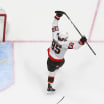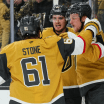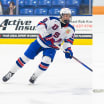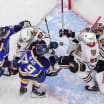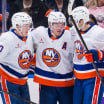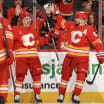BOCA RATON, Fla. -- As part of continuing tweaks to the coach's instant replay challenge, the NHL will introduce two cameras located at each blue line in the 16 buildings hosting games during the Stanley Cup Playoffs.
Colin Campbell, the senior vice president of hockey operations for the League, made the announcement Monday at the first day of the three-day meeting of general managers here.
NHL adding blue-line cameras for playoffs
Tweak to coach's challenge system introduced at GM meetings
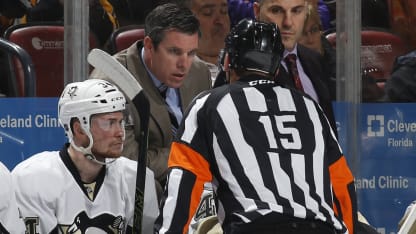
© Joel Auerbach/Getty Images
"That's the one in-season tweak we can make," Campbell said. "It's not a rule change; it's just helping make the process better."
The League experimented with these camera placements during the 2016 Coors Light NHL Stadium Series games last month in Minneapolis and Denver, and also during the 2016 Honda NHL All-Star Game in Nashville in January.
"It's been great," Campbell said of the technology.
Campbell said team video personnel will have access to the video from these cameras to help make decisions on when to challenge plays involving potential missed offside calls.
Despite that tweak, the consensus among the general managers is that the coach's challenge has worked well. The challenge, which can be used on goals involving the potential of offside or goaltender interference, was introduced at the start of the 2015-16 season. A team must have its timeout to challenge a goal.
There have been 216 challenges this season and 55 goals have been overturned. Of those challenges, 138 have been for goaltender interference and 78 have been for offside.
"I think the really big mistakes that were being made are out of the game and I think it's good," Philadelphia Flyers GM Ron Hextall said. "I think if you look back at a game and it's a 3-2 game and there is a huge mistake on a goal, I think we've gotten those out. I'm sure at some point we look at maybe trying to shorten the time period. But this is fresh right now and there are certain things that I think the guys have done a good job working through. I really like it."
Other than the introduction of the cameras on the blue lines for the postseason, the rest of the discussion on the topic revolved around where the League is with its review process once a challenge is issued.
As part of that presentation, the general managers were shown nine plays which resulted in a review, six for goaltender interference and three for offside. The managers were asked to vote on the plays and there was no consensus on the correct call to be made, with the vote generally running two-thirds to one-third on each challenge, according to Campbell.
"It's not an easy thing to wrap your arms around. We get calls from coaches all year long, they just want to know -- and not just their game, from all the games they watch -- why was this call made this way?" Campbell said. "They say, 'I want to know going forward when I use my coach's challenge.'
"So I think it was a good day to show where we're at with the coach's challenge and where we can get to. I think the process is what we thought exactly. We also want to make sure going into the playoffs that there's consistency because that's where the meat of the issue really comes forward. No one wants to leave the arena in the playoffs, particularly in a deciding game, thinking you could have got a better call with video review."
That has happened under the new system, according to the managers.
"It's about getting the egregious ones, the ones that are really, really, really blatant and getting them right," Winnipeg Jets general manager Kevin Cheveldayoff said. "I think that's been really good.
"Overall it's done what it was intended to do, to help with the egregious call. I still think you're going to have the judgment call no matter what you do. Even as a group there's always gray areas."
There was some discussion about moving part of the review process to the NHL Situation Room in Toronto, which handles traditional goal reviews. Presently the referees on the ice, with use of an HD tablet located at the scorer's table, rule on coach's challenges. Some have argued that Toronto is better equipped to make rulings because of their access to superior technology.
But there was not an appetite among the general managers to make any immediate change.
"The process is working as planned," said Ken Holland, the general manager of the Detroit Red Wings. "We'll go through the stretch run here and into the playoffs and then we'll look at it again when the season is over at our June meetings."
The managers also were debriefed on the NHL All-Star Game.
Various aspects of the process were discussed, including fan voting and the potential for more severe penalties to players without an excused absence through injury who do not attend the All-Star Game. Currently a player is suspended for one regular-season game for missing the All-Star Game.
While no decisions were made on those topics, the satisfaction with the new format was quite high.
For the first time the All-Star Game featured 11-player teams representing each of the four divisions playing in a round-robin tournament of 3-on-3 hockey under the same rules of the regular-season overtime format instituted at the start of the 2015-16 season. The winning team received $1 million.
The Pacific Division won the title this season.
"It was enjoyable for everybody from the players to the fans and I think it was the potentially the best All-Star Game, at least over the last 20 years, from a competition standpoint, from a fan standpoint, from a player experience," New Jersey Devils general manager Ray Shero said. "It was just a lot of fun and it rolled into a great four-day weekend for the League and for the players and certainly the enjoyment for both was the most important aspect of it and really helped grow the game and showed what it can be."
The meetings continue Tuesday with the managers breaking into smaller groups to tackle a variety of topics, including possible reductions in the size of goaltending equipment and a tweak to current head-contact rules.
